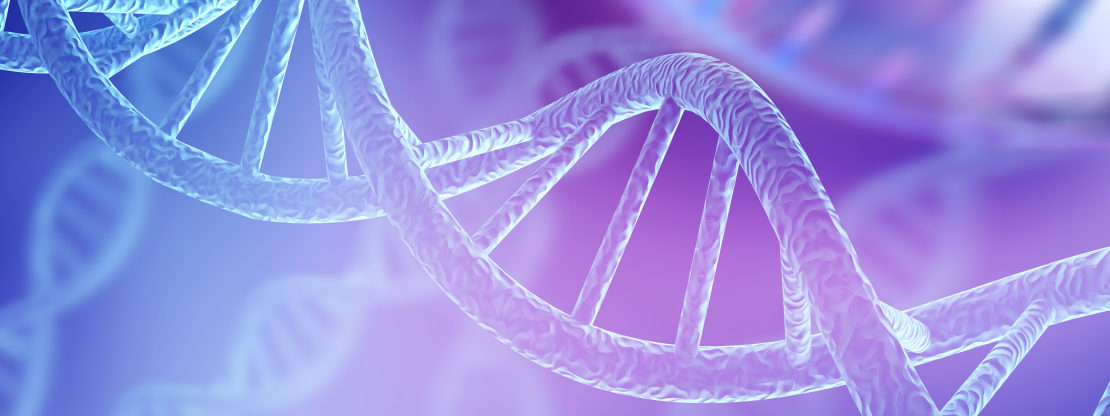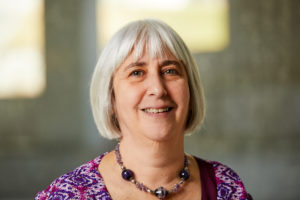Linking genetics and Parkinson’s: A Q&A with genetics expert Dr. Ellen Sidransky
May 14, 2019

As a pediatrician with expertise in medical genetics, Dr. Ellen Sidransky never expected to become one of the world’s foremost experts on Parkinson’s disease, a neurodegenerative disorder that typically affects older people.

But a chance meeting more than two decades ago with a patient who had an early form of the disease changed the course of her career and revolutionized our understanding of a condition that continues to defy attempts to slow or stop its progression.
Sidransky went on to become the first to link an increase in Parkinson’s risk to mutations in the gene GBA, which produces an enzyme that breaks down a common lipid located in lysosomes, cells’ internal waste removal systems. Alterations in GBA are now known to be the most common genetic risk factor for Parkinson’s and dementia with Lewy bodies, and are a major target for experimental medications.
She currently serves as chief of the Section on Molecular Neurogenetics within the National Human Genome Research Institute of the National Institutes of Health. In addition to her work with Parkinson’s, she is an international authority on Gaucher disease, a rare genetic disorder caused by problems with GBA, and dementia with Lewy bodies, a disorder that has much in common with Parkinson’s and Alzheimer’s diseases.
Later this summer, Van Andel Research Institute will honor Sidransky and her transformative contributions to science and medicine with the 2019 Jay Van Andel Award for Outstanding Achievement in Parkinson’s Disease Research during our annual Grand Challenges in Parkinson’s Disease symposium. You can learn more about Grand Challenges and Rallying to the Challenge, a parallel meeting for people with Parkinson’s, at grandchallengesinpd.org.
In the meantime, we chatted with Dr. Sidransky about the discovery of GBA, how it changed our understanding of genetics and Parkinson’s, and what gives her the most hope for the future of treatment.
Q: How did you first get interested in neuroscience? In Gaucher disease? In Parkinson’s?
ES: I was initially trained in pediatrics and then decided to specialize in medical genetics. When I began my fellowship training in genetics, I was looking for a place to learn molecular biology in a rare disease-focused laboratory. I chose to work on Gaucher disease with Dr. Edward Ginns, who had just cloned the responsible gene, GBA1, which codes for glucocerebrosidase, the enzyme missing in Gaucher disease. I was interested in Gaucher disease because I knew that there was broad variability in patient manifestations, ranging from critically ill babies and children to asymptomatic older adults. Naively, I thought that I would explain all of the symptoms by looking for mistakes in the DNA.
In the process of this work, I evaluated patients with diverse stories, and learned about many different aspects of the disease through these interactions. I also worked in the laboratory, and my first projects were trying to correlate patient manifestations with their GBA1 mutations and working on making mouse models.
My interest in Parkinson’s disease began with a single patient who I met in the late 1990s. She had relatively mild Gaucher disease, but an early onset, treatment-refractory form of Parkinson’s disease. As a pediatrician, I had no experience with Parkinson’s disease, but questioned whether the two disorders might in some way be related. I then identified other patients with both Gaucher and Parkinson’s disease, and started to realize that Parkinson’s disease was reported more frequently than expected among parents and grandparents of our patients with Gaucher disease. These were people who carried one mutation in GBA1, but did not have Gaucher disease. My emphasis then turned to looking for GBA1 mutations in groups of patients with Parkinson’s disease, and the rest is history! GBA1 mutations are now appreciated as the most common genetic risk factor for both Parkinson disease and dementia with Lewy bodies.
Q: How has our understanding of genetics in Parkinson’s changed in the last decade?
ES: The discovery of GBA1 as a risk factor for Parkinson’s disease has greatly impacted genetic studies related to Parkinson’s disease. I must say that it did take quite a while for this observation to become accepted in the Parkinson’s community, in part because earlier large genetic (GWAS) studies had not picked up this gene. But after I spearheaded a multicenter international study, published in the New England Journal of Medicine in 2009, which reported on GBA1 in more than 5,000 patients with Parkinson disease and 5,000 controls, much more attention is now focused on GBA1. It has led to an appreciation of the role of the lysosome, a small organelle where the enzyme glucocerebrosidase works to break down lipids, in Parkinson’s disease, and to the identification of many other genes related to lysosomal function.
Q: How does an improved understanding of genetic risk impact development of diagnostic methods? Potential new therapies?
ES: Identifying a gene or risk factor provides us with a starting point. This is particularly helpful in the case of GBA1, since we know a lot about this gene because of its role in Gaucher disease. Therapeutic approaches and diagnostic tests used for Gaucher disease may ultimately impact how we identify and treat patients with Parkinson’s disease. Also, therapies may need to be tailored for patients with different genetic causes of their disease.
Q: What should someone who is newly diagnosed with Parkinson’s know about genetics in PD? About GBA specifically?
ES: It is important to realize that the genetics of Parkinson’s disease are complex, and it is likely that multiple different genes contribute to the development of this disorder. GBA1 is an important risk factor, but it should be remembered that the vast majority of people with GBA1 mutations never develop Parkinson’s. However, this association may help us to identify other risk factors or genes. Knowing about your genetic mutations might ultimately be important as new therapies are developed. It is important to understand that within a family, not everyone with a GBA1 mutation will develop Parkinson’s. In fact, we are following many pairs of siblings with mutations, where one sibling has Parkinson’s disease and the second does not.
Q: Looking back on your GBA discovery, was there a “wow” moment when you realized the significance of the finding?
ES: There was in fact a “wow” moment. Some years after identifying our first patient with Gaucher disease and Parkinson’s disease, I was contacted by a former student who was working as a neuropathology fellow. She had just performed an autopsy on a patient with Parkinson’s disease and discovered that the patient also had Gaucher disease. She asked if I would like any tissue from the autopsy. I was excited about this prospect, but asked that she also send a few additional samples from other patients with Parkinson’s disease. Three small brain samples arrived, packed in dry ice, but the labeling was not clear. We extracted DNA from each, and found that all three samples carried GBA1 mutations — one had two mutations and was the one with Gaucher disease, but the other two random Parkinson’s disease patients were carriers! This launched our investigations into the prevalence of GBA1 mutations in Parkinson’s disease.
Q: Where do you see Parkinson’s research going in the next five years?
ES: I believe that in the next five years, we will identify more genetic risk factors, many of which will be in pathways similar to those involved with GBA1. My hope is that this will drive new therapeutic strategies.
Q: What is the latest on GBA — what do we know now that we didn’t know a year or two ago?
ES: The story is still evolving. We now see that in Parkinson’s mouse models, GBA1 mutations, or the absence of one copy of the gene, accelerates the disease course. We have also seen that some small molecule chaperone drugs that increase glucocerebrosidase, can decrease the amount of alpha-synuclein in Parkinson’s disease models.
Q: What is the most exciting thing going on right now in your field? What gives you the most hope?
ES: I am excited about the new disease models made from patient-derived cells. I am hopeful that we can improve and test therapies in these models, and that the results will expedite the development of drugs for clinical use. I also hope that small-molecule chaperones will work, because they will potentially be inexpensive to produce and easy to administer.
Dr. Sidransky will receive the 2019 Jay Van Andel Award for Outstanding Achievement in Parkinson’s Disease Research at 8:00 a.m. on Aug. 21, the first day of Grand Challenges in Parkinson’s Disease. For more information on the symposium, the Rallying to the Challenge meeting and how to register, please visit grandchallengesinpd.org. Read more about her and her work on the National Human Genome Research Institute’s website here.
